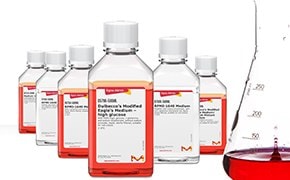Application Page 0618
Test Dynamic Product Table
Left Primary Content
- A step-by-step method describing the photometric determination of ammonium in effluents with high Chemical Oxygen Demand (COD) value using Spectroquant® test kits and photometer.
- A step-by-step procedure for the photometric determination of Ammonium in sewage sludge using Spectroquant® test kits and photometer for a precise and quantitative analysis.
- Step-by-step accurate reflectometric determination of ammonium in wastewater with Nessler’s reagent or Indophenol blue using Reflectroquant® system and test strips.
- Preparation of a standard solution for COD/chloride
- Nitrate in Fruit Juices
- Step-by-step method describing the reflectometric determination of nitrate levels in various vegetables after reduction to nitrite and detection with Griess reagent using Reflectoquant® system and test strips.
- Step-by-step method describing the reflectometric determination of nitrate in wastewater after reduction to nitrite and detection with Griess reagent using Reflectoquant® test strips and reflectometer.
- Step-by-step method describing the reflectometric determination of nitrite levels in wastewater using Reflectoquant® test strips and reflectometer, ideal for on-site testing.
- An easy-to-use, economical, and smartphone-based reliable pH determination of milk and milk products using the MQuant® pH test strips and the MQuant® StripScan App.
- Photometric determination of phosphate content of effluents using Spectroquant® test kits and photometer for a precise quantitative analysis.
Right Content Headline
- Protocols and articles about sample preparation, liquid chromatography, gas chromatography, mass spectrometry, photometry & reflectometry, NMR, atomic spectroscopy, thin layer chromatography, titration, Karl Fisher, and wet chemical analysis.
- Atomic spectroscopy uses the energy absorbed or emitted by electrons to identify and quantify the elemental composition of a sample. It includes various analytical techniques, such as AAS, AES, FAA, GFAA, ICP-OES, ICP-MS and XRF.
- Atomic spectroscopy uses the energy absorbed or emitted by electrons to identify and quantify the elemental composition of a sample. It includes various analytical techniques, such as AAS, AES, FAA, GFAA, ICP-OES, ICP-MS and XRF.
- Reference materials are critical to method validation, calibration, qualification, and measurement of uncertainty. The proper selection of the reference material best suited for the testing application is vital, as results are only as accurate as the reference.
- Gas chromatography is a common analytic technique used to separate and analyze volatile compounds in the gas phase. GC is applied in many industries for quality control, and to identify and/or quantify compounds in a mixture.
- Protocols and technical articles relating to high-performance liquid chromatography (HPLC) for large molecules and small molecules, and to low-pressure liquid chromatography (LPLC)
- High performance liquid chromatography (HPLC) can be used to separate and identify different large biomolecules such as protein and peptides in a sample. It is based on the pumping of a sample with a solvent (mobile phase) through a column packed with sorbent material (stationary phase) at a high pressure.
- Low pressure liquid chromatography (LPLC) is a chromatographic technique that operates at low pressures to drive the mobile phase onto the column containing a stationary phase by the action of a pump.
- Small molecules are ions and compounds of molecular weight typically less than 900 daltons. These compounds can be effectively separated and analyzed by HPLC, UHPLC and LC-MS using mainly silica particles or monolithic stationary phases with a broad range of column chemistries (modifications).
- Mass spectrometry (MS) is an analytical tool used to identify compounds, determine chemical structure, and assess isotopic abundance. In MS, samples are ionized, and the resulting ions are identified based on their mass-to-charge (m/z) ratios.
Test Feature Tile

This is the test description for the first feature tile
asdijo asiodjas dioajsd as
asiodj asdiojasd asiojdasasdioj
asdiojas dasiojdas diojasd asiodj
asiodjasd asiodjas dioasjdasdasas

This is the test description for the feature tile 2
aiodjas diojasd
asijd asdiojasd iojas
dijas diojasd asiodjasd
asiodjas diojasd asdiojasd

This is the test description for the feature tile 3
asiodj asdiojas dasiojd
asiodja sdiojasd asiodjas d
asiodja sdiojasd asidjasd ioasjd
aiosjd asdiojasd asiojdas diojasd

This is the test description for the feature tile 4
asiodja sdiojad aiodj
asiodjas dioasjd asdiojasd
asiodjas dioasjd asdjioas dasiodj
asiodjas dioasjd asdiojasd asdhsd

Reference Headline
Static Table Headline | ||
|---|---|---|
Header1 | Header2 | Header3 |
| This is the first row and first column of a static table | This is the first row and second column of a static table | This is the first row and third column of a static table |
| 0.11 | ROW2 | 0.33 |
| ROW3 | 0.22 | ROW3 |
This is the test description for the Text Component
asiudj asiojd asiodj
asiodj asdiojasd asiodj
asiodjas dioasjd asdiojasd
aiosjd asdiojasd asiodjas dioja
sdiasjd asiodjas dioasjdas dioja
Test Vertical Workflow
This is the test description for the Vertical Workflow
asdioja sdiojasd aioasjd asdioj
asiodj asdiojas daiojd asiodj
asidj asiojd asdiojasd asiodj
asiodj adiojas dasiodjas dasiodj

Title 1
This is the test description for the first tile
asiodj asiodj aasdioj aiodj
aiodja diajsd asdiojasd asidj
asidja sdioasjd asdiojasd asdioj
asdiojas dasiojda dioasjda sdioasjd

Title 2
This is the test description for the second tile
asiodj asdiojas dasiojd
aiosjda sdiojasd asiodj
asidja sdioasjd asdiojasd
asioodja dioasjd asdijasd

Title 3
This is the test description for the third tile
asdioja diojasd asiodj
asdija sdioasjd adiojasd
asiodjas dioasjdas dioasjd
asdiojas dioasjda sdiojasd
Para seguir leyendo, inicie sesión o cree una cuenta.
¿No tiene una cuenta?









